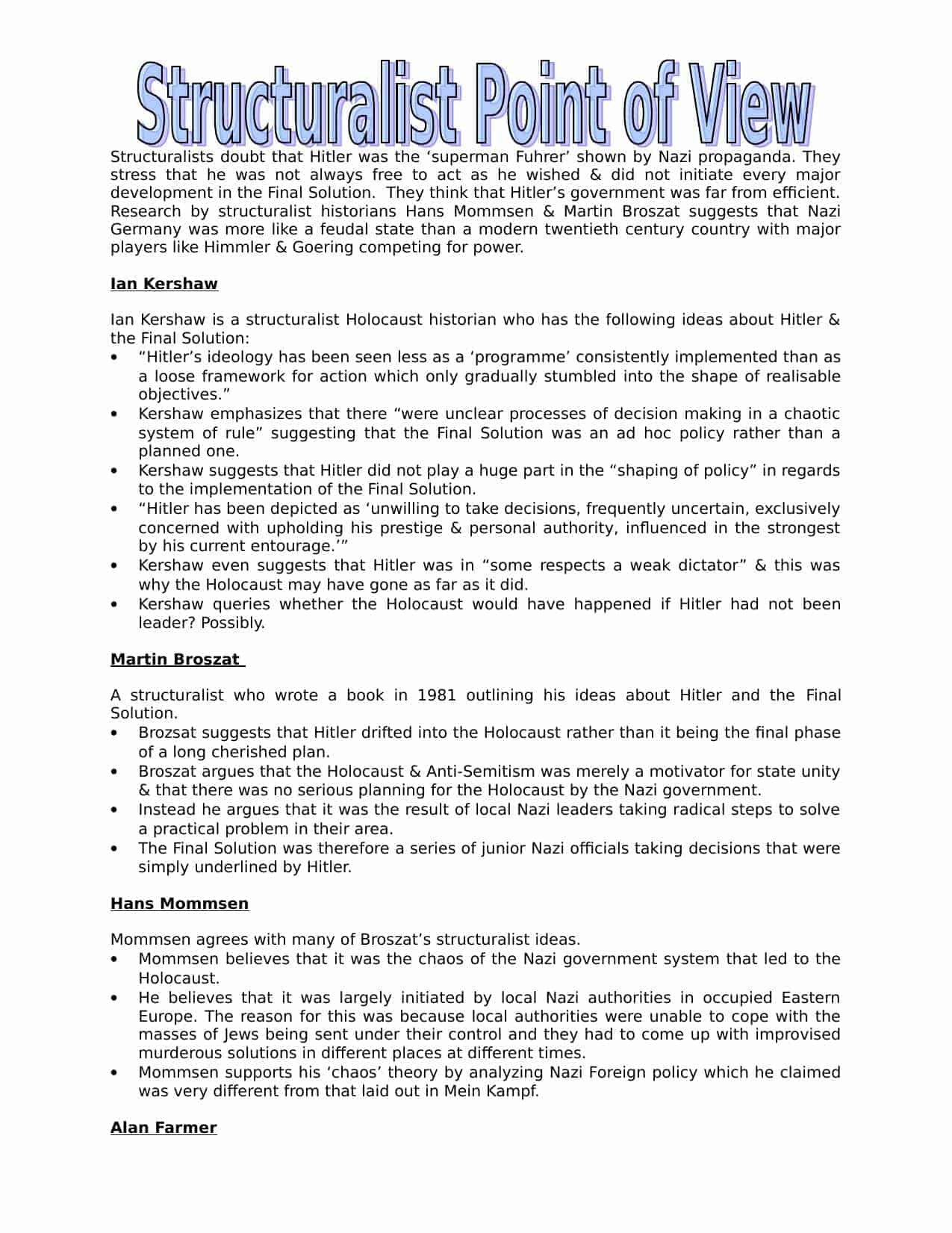Download Structuralism & Nazi Germany
Click the button below to download this worksheet for use in the classroom or at home.
Download →
Lesson Snapshot:
Structuralists doubt that Hitler was the ‘superman Fuhrer’ shown by Nazi propaganda. They stress that he was not always free to act as he wished & did not initiate every major development in the Final Solution. They think that Hitler’s government was far from efficient. Research by structuralist historians Hans Mommsen & Martin Broszat suggests that Nazi Germany was more like a feudal state than a modern twentieth century country with major players like Himmler & Goering competing for power.
Ian Kershaw:
Ian Kershaw is a structuralist Holocaust historian who has the following ideas about Hitler & the Final Solution:
• “Hitler’s ideology has been seen less as a ‘programme’ consistently implemented than as a loose framework for action which only gradually stumbled into the shape of realisable objectives.”
• Kershaw emphasizes that there “were unclear processes of decision making in a chaotic system of rule” suggesting that the Final Solution was an ad hoc policy rather than a planned one.
• Kershaw suggests that Hitler did not play a huge part in the “shaping of policy” in regards to the implementation of the Final Solution.
• “Hitler has been depicted as ‘unwilling to take decisions, frequently uncertain, exclusively concerned with upholding his prestige & personal authority, influenced in the strongest by his current entourage.’”
• Kershaw even suggests that Hitler was in “some respects a weak dictator” & this was why the Holocaust may have gone as far as it did.
• Kershaw queries whether the Holocaust would have happened if Hitler had not been leader? Possibly.
Martin Broszat:
A structuralist who wrote a book in 1981 outlining his ideas about Hitler and the Final Solution.
• Brozsat suggests that Hitler drifted into the Holocaust rather than it being the final phase of a long cherished plan.
• Broszat argues that the Holocaust & Anti-Semitism was merely a motivator for state unity & that there was no serious planning for the Holocaust by the Nazi government.
• Instead he argues that it was the result of local Nazi leaders taking radical steps to solve a practical problem in their area.
• The Final Solution was therefore a series of junior Nazi officials taking decisions that were simply underlined by Hitler.
Hans Mommsen:
Mommsen agrees with many of Broszat’s structuralist ideas.
• Mommsen believes that it was the chaos of the Nazi government system that led to the Holocaust.
• He believes that it was largely initiated by local Nazi authorities in occupied Eastern Europe. The reason for this was because local authorities were unable to cope with the masses of Jews being sent under their control and they had to come up with improvised murderous solutions in different places at different times.
• Mommsen supports his ‘chaos’ theory by analyzing Nazi Foreign policy which he claimed was very different from that laid out in Mein Kampf.
Alan Farmer:
In the introduction of his book ‘Anti-Semitism and the Holocaust’ Farmer examines all of the different debates that take place about the Holocaust and the different points of view in regards to whether the Holocaust was planned or ad hoc.
Worksheet Lesson Plan:
- Aimed at Students studying across UK Year 7,8 & 9 or equivalent
- Premium resource
- Use as you wish in the classroom or home environment
- Lesson plan on Structuralism & Nazi Germany.
- Contains questions throughout the study worksheet.
